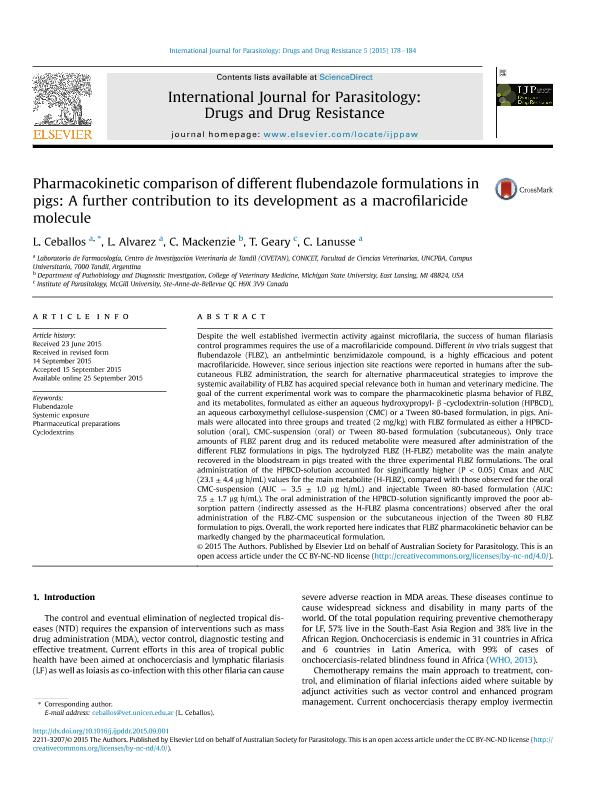Mostrar el registro sencillo del ítem
dc.contributor.author
Ceballos, Laura

dc.contributor.author
Alvarez, Luis Ignacio

dc.contributor.author
Mackenzie, C.
dc.contributor.author
Geary, T.
dc.contributor.author
Lanusse, Carlos Edmundo

dc.date.available
2019-09-18T19:59:13Z
dc.date.issued
2015-12
dc.identifier.citation
Ceballos, Laura; Alvarez, Luis Ignacio; Mackenzie, C.; Geary, T.; Lanusse, Carlos Edmundo; Pharmacokinetic comparison of different flubendazole formulations in pigs: A further contribution to its development as a macrofilaricide molecule; Elsevier Ltd; International Journal for Parasitology: Drugs and Drug Resistance; 5; 3; 12-2015; 178-184
dc.identifier.issn
2211-3207
dc.identifier.uri
http://hdl.handle.net/11336/83876
dc.description.abstract
Despite the well established ivermectin activity against microfilaria, the success of human filariasis control programmes requires the use of a macrofilaricide compound. Different in vivo trials suggest that flubendazole (FLBZ), an anthelmintic benzimidazole compound, is a highly efficacious and potent macrofilaricide. However, since serious injection site reactions were reported in humans after the subcutaneous FLBZ administration, the search for alternative pharmaceutical strategies to improve the systemic availability of FLBZ has acquired special relevance both in human and veterinary medicine. The goal of the current experimental work was to compare the pharmacokinetic plasma behavior of FLBZ, and its metabolites, formulated as either an aqueous hydroxypropyl- β -cyclodextrin-solution (HPBCD), an aqueous carboxymethyl cellulose-suspension (CMC) or a Tween 80-based formulation, in pigs. Animals were allocated into three groups and treated (2 mg/kg) with FLBZ formulated as either a HPBCD-solution (oral), CMC-suspension (oral) or Tween 80-based formulation (subcutaneous). Only trace amounts of FLBZ parent drug and its reduced metabolite were measured after administration of the different FLBZ formulations in pigs. The hydrolyzed FLBZ (H-FLBZ) metabolite was the main analyte recovered in the bloodstream in pigs treated with the three experimental FLBZ formulations. The oral administration of the HPBCD-solution accounted for significantly higher (P < 0.05) Cmax and AUC (23.1 ± 4.4 μg h/mL) values for the main metabolite (H-FLBZ), compared with those observed for the oral CMC-suspension (AUC = 3.5 ± 1.0 μg h/mL) and injectable Tween 80-based formulation (AUC: 7.5 ± 1.7 μg h/mL). The oral administration of the HPBCD-solution significantly improved the poor absorption pattern (indirectly assessed as the H-FLBZ plasma concentrations) observed after the oral administration of the FLBZ-CMC suspension or the subcutaneous injection of the Tween 80 FLBZ formulation to pigs. Overall, the work reported here indicates that FLBZ pharmacokinetic behavior can be markedly changed by the pharmaceutical formulation.
dc.format
application/pdf
dc.language.iso
eng
dc.publisher
Elsevier Ltd
dc.rights
info:eu-repo/semantics/openAccess
dc.rights.uri
https://creativecommons.org/licenses/by-nc-sa/2.5/ar/
dc.subject
Cyclodextrins
dc.subject
Flubendazole
dc.subject
Pharmaceutical Preparations
dc.subject
Systemic Exposure
dc.subject.classification
Ciencias Veterinarias

dc.subject.classification
Ciencias Veterinarias

dc.subject.classification
CIENCIAS AGRÍCOLAS

dc.title
Pharmacokinetic comparison of different flubendazole formulations in pigs: A further contribution to its development as a macrofilaricide molecule
dc.type
info:eu-repo/semantics/article
dc.type
info:ar-repo/semantics/artículo
dc.type
info:eu-repo/semantics/publishedVersion
dc.date.updated
2019-07-24T17:41:11Z
dc.journal.volume
5
dc.journal.number
3
dc.journal.pagination
178-184
dc.journal.pais
Países Bajos

dc.journal.ciudad
Amsterdam
dc.description.fil
Fil: Ceballos, Laura. Consejo Nacional de Investigaciones Científicas y Técnicas. Centro Científico Tecnológico Conicet - Tandil. Centro de Investigación Veterinaria de Tandil. Universidad Nacional del Centro de la Provincia de Buenos Aires. Centro de Investigación Veterinaria de Tandil. Provincia de Buenos Aires. Gobernación. Comision de Investigaciones Científicas. Centro de Investigación Veterinaria de Tandil; Argentina
dc.description.fil
Fil: Alvarez, Luis Ignacio. Consejo Nacional de Investigaciones Científicas y Técnicas. Centro Científico Tecnológico Conicet - Tandil. Centro de Investigación Veterinaria de Tandil. Universidad Nacional del Centro de la Provincia de Buenos Aires. Centro de Investigación Veterinaria de Tandil. Provincia de Buenos Aires. Gobernación. Comision de Investigaciones Científicas. Centro de Investigación Veterinaria de Tandil; Argentina
dc.description.fil
Fil: Mackenzie, C.. Michigan State University; Estados Unidos
dc.description.fil
Fil: Geary, T.. McGill University; Canadá
dc.description.fil
Fil: Lanusse, Carlos Edmundo. Consejo Nacional de Investigaciones Científicas y Técnicas. Centro Científico Tecnológico Conicet - Tandil. Centro de Investigación Veterinaria de Tandil. Universidad Nacional del Centro de la Provincia de Buenos Aires. Centro de Investigación Veterinaria de Tandil. Provincia de Buenos Aires. Gobernación. Comision de Investigaciones Científicas. Centro de Investigación Veterinaria de Tandil; Argentina
dc.journal.title
International Journal for Parasitology: Drugs and Drug Resistance
dc.relation.alternativeid
info:eu-repo/semantics/altIdentifier/doi/https://doi.org/10.1016/j.ijpddr.2015.09.001
dc.relation.alternativeid
info:eu-repo/semantics/altIdentifier/url/https://www.sciencedirect.com/science/article/pii/S2211320715300099
Archivos asociados
